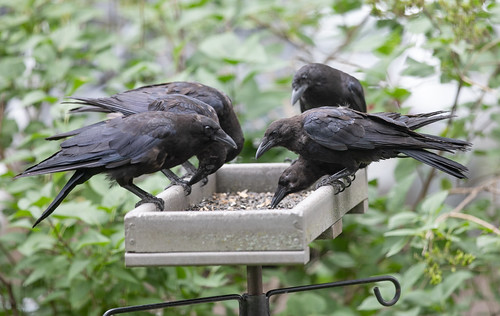 |
| Photo by Stan Tekiela, from my book, Into the Nest |
My grandson Walter, who was exactly two months old October 14, is very much like a hatchling songbird, only with a tiny bit of hair on his head. Most newly hatched songbirds have at least a bit of down, but Walter is more like a baby woodpecker in that respect, hatched with not a single down feather.
Nestling songbirds, woodpeckers, hummingbirds, raptors, and several others are called altricial—that is, they hatch out with eyes closed and utterly helpless. Altricial baby birds do have the instinct to open their mouths when they sense a parent near, and they poop as soon as they’ve eaten, in those respects very much like newborn humans. Birds with altricial young feed their helpless babies as tenderly as human mothers do. But unlike us mammals, most birds cannot produce that food within their own bodies—they must hunt it out and bring it back to the nest, whether the food is an Osprey or eagle’s fresh fish, a robin’s worms, or a hummingbird’s slurry of nectar and tiny insects.
Mammals produce milk, so have a different approach. Baby squirrels nestle against their mothers through the night so they can be fed whenever they want to nurse—mother squirrels probably sleep right through nighttime feedings, unlike human mothers such as my daughter when babies needs to eat every three or four hours.
Altricial bird parents need light to procure food, so night feedings aren’t an option. To make up for it, many species spend just about every moment from sunrise to sunset searching for food and feeding their nestlings and then fledglings. Doves and pigeons are an exception in that they produce in their crop a substance called pigeon milk, in composition very much like mammalian milk. Nevertheless, like other altricial species, they only feed their young during daytime.
Now that it’s mid-October, most of the baby songbirds produced this year are on their own. Baby chickadees have left their parents and siblings and each joined a different winter flock from its family members. The first baby robins to fledge this year have been on their own since early summer, and the one or two subsequent broods each pair of robins raised are also on their own—robins associate in large flocks, so it’s not like the young won’t have adults around showing them the ropes as they travel to new places. Some swallows and probably other songbirds stick with their own parents through migration, but that is probably the exception rather than the rule.
Many corvids stick together as families longer than their fellow songbirds. My neighborhood pair of crows fledged four young this year, and five members of the family are still coming to my tray feeder as a group.
 |
| This is the whole family back in August. At least five of them are still together. |
It’s been tricky keeping track of my backyard Blue Jays when so many migrants have been passing through, but one adult keeps coming to me for peanuts if it’s in hearing range when I whistle, so I can recognize that one. This past weekend I saw a Blue Jay in the spruce tree right next to my new upstairs home office, and when I whistled, it came to a closer branch and peeked in the window, so I tossed a peanut out and it rocketed to the ground to retrieve it. And instantly, another Blue Jay started making begging sounds and fluttering its wings, and the first bird flew up and gave it a peanut kernel.
I’d taken a lot of photos of that baby and its brood back on August 7, a week before Walter was born—at that point, the babies were fine fliers with half-grown tails.
They’d presumably hatched sometime the first week of July and fledged three weeks later. The Blue Jay entry in Cornell’s Birds of the World states that “Parents feed offspring for at least 1, sometimes up to 2, mo.” after fledging, but it appears that feeding a young one this late, at least 10 weeks after fledging, is either exceptional or I’m one of the few people lucky enough to have observed it.
I don’t know if Blue Jays who stick with their parents like this have a better or worse prognosis than more independent young. There is probably a lot of value in self-sufficiency, but also in getting occasional free lunches and extra guidance.
Blue Jay migration isn’t at all understood—we have no idea how many of the birds heading south are adults versus young, or how long young normally associate with their parents, and how long after going their own ways family members recognize one another. I suspect this particular adult is going to be spending the winter here based on the fact that it’s been caching away half the peanuts I give it.
 |
| Should I tell Russ where this jay is caching peanuts? |
So I’ll be paying attention to try to tease out the relationships between it and other Blue Jays as the season progresses. None of them are banded, much less color marked, and I suspect if any were trapped here, they’d consider that the kind of betrayal that would send them packing for good.
Looking at my tiny, dependent grandbaby, it’s hard to imagine just how quickly baby Blue Jays grow up. But it’s lovely to realize that when a baby Blue Jay—even a full-sized one who could be off on its own—needs a handout, a parent is seemingly happy to oblige. It was lovely of my friendly Blue Jay to give me this glimpse into their natural history, giving me something to wonder about during National Blue Jay Awareness Month while I’m gazing into the eyes of our family’s own little nestling.


